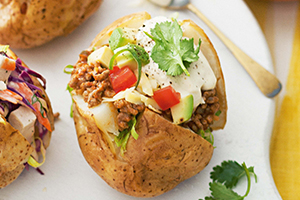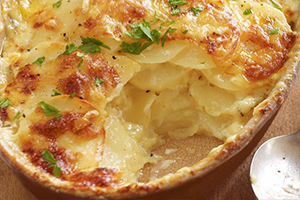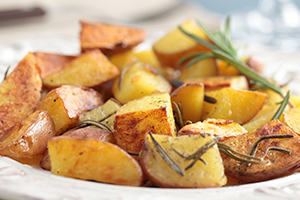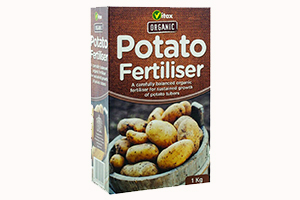Confused about the different types of potatoes? Not sure what to plant and when? Get under the skin of all things potatoes by reading our guide.
The good news is, potatoes are easy to grow – just plant one seed potato, and dig up lots of potatoes a few months later!
Potato Types
There are three main types of potatoes, they need to be purchased, chitted and planted and harvested at different times of the year. Your first decision is what cropping type you want to grow:
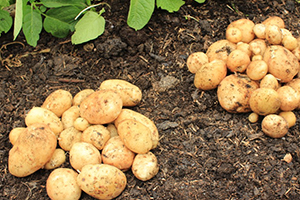 First Earlies:
First Earlies:
- Small, new potatoes.
- Harvest approximately 10 weeks from planting.
- Grow in bags, containers, or in the ground.
- Recommended varieties: Rocket and Foremost. Both of these varieties are perfect for boiling. ‘Rocket’ is also perfect for salads.
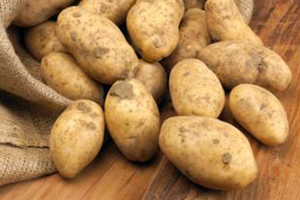

- Small, new potatoes.
- Harvest approximately 10 weeks from planting.
- Grow in bags, containers, or in the ground.
- Recommended varieties: Kestrel is good for roasting and mashing. Charlotte is another good boiler.
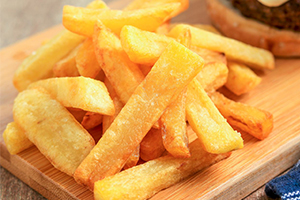

- Larger potatoes, ideal for baking and roasting.
- Ready to harvest approximately 10 weeks from planting.
- Best grown in the ground where there is more room, but can also be grown in bags and containers.
- Recommended varieties: ‘Desiree is a popular red variety and makes a great all-rounder. Maris Piper is the chip shop potato. It’s versatile, a high yielder and stores well.
Chitting 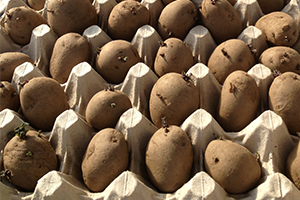

Chitting starts the potatoes off. Place your seed potatoes in a shallow tray or egg tray in a cool, light, frost free place, several weeks prior to planting. The seed potatoes will develop strong sprouts (chits) after around 6 weeks which will help them grow quickly once planted. This is a helpful but not essential process.
Soil Preparation and Planting
Soil Preparation (Ground): Add plenty of farmyard manure into your plot and then fill back in. Bury the tubers using a trowel or bulb planter.
Soil Preparation (Containers): If you would like to grow potatoes in a container choose a pot with handles to make it easy to move to a sheltered spot if frost threatens. As a guide, a container 45cm (18in) deep and 40cm (16in) in diameter holds 2 seed potatoes. Use a peat-free garden compost and fill about one third of the pot/bag, mix with perlite to aid drainage. As the foliage grows add more compost until you are near the top of the bag.
See the table below for planting information.


Growing
Use a high potash feed like Potato Fertiliser or Tomorite. Water well but take care not to overwater.
When potatoes have emerged a few inches, pull earth around the plant with a rake, leaving peaked rows. Earthing-up gives the plant more soil to grow in, stops sunlight turning exposed tubers green and improves drainage.
Harvesting 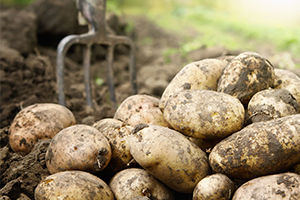

Before harvesting, carefully scrape away some soil and check that the potatoes have grown to the size that you like. First Earlies are best enjoyed when they are small and fresh in June-August and Second Earlies follow on. Maincrop varieties are best left until October for size and skin set. Once the Maincrop foliage has died back, the potatoes should be left in the ground for 2-3 weeks to allow the skins to set, ready for storing. We recommend using a potato fork or a scoop to allow crops to be lifted without damage.
Storing
Dry the tubers by laying them on the soil for a few hours once you’ve dug them up. Some varieties (generally Maincrop) are good keepers and will remain dormant and not start sprouting until April. The storage conditions should be cool, frost free, airy and away from light as this can cause greening. Jute fibre bags allow for excellent air circulation, paper sacks are good but avoid plastic.
Lastly – enjoy the fruits of your labour!
Visit our online shop where you will find everything you need to get growing!
